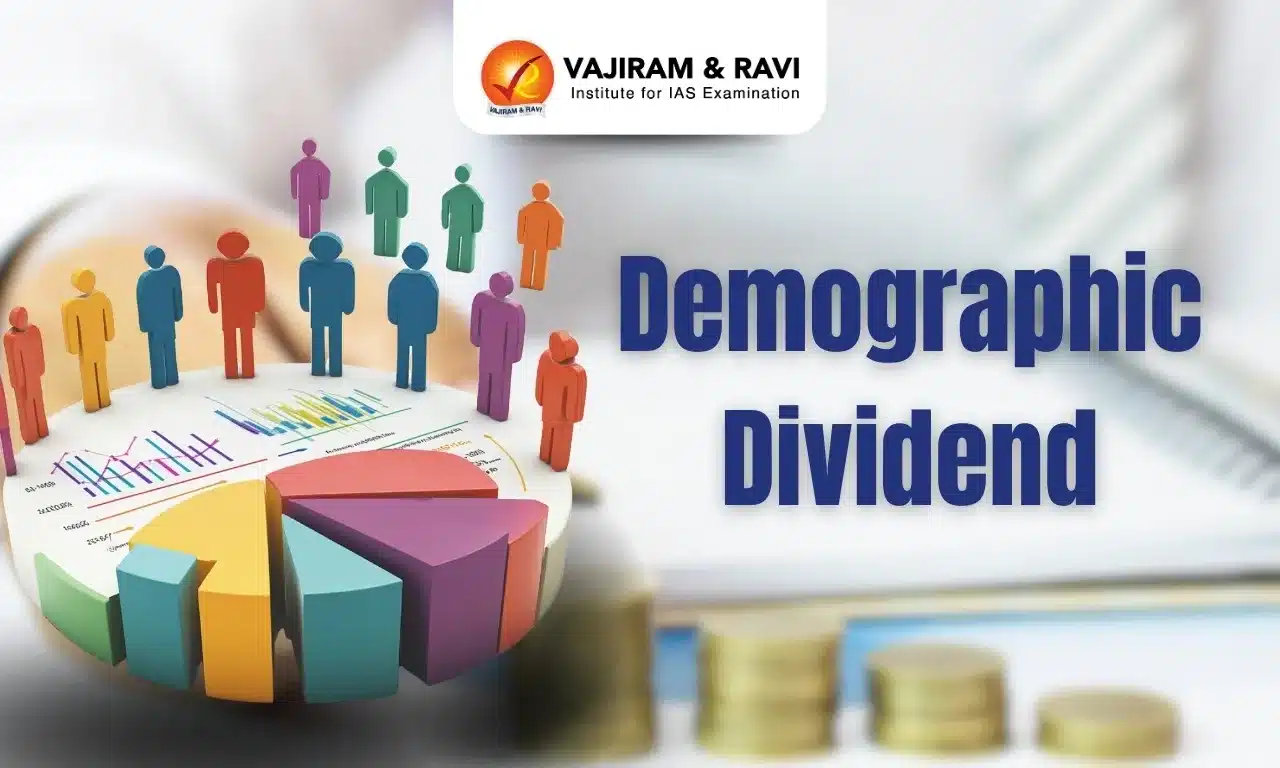Demographic dividend is “the economic growth potential that can result from shifts in a population’s age structure, mainly when the share of the working-age population is larger than the non-working-age share of the population”. India stands at a demographic crossroads. With over 50% of its 1.4 billion population under 25, India has one of the world’s youngest populations. This demographic bulge represents both a historic opportunity and a formidable challenge.
Effectively leveraging this youthful demography could propel the economy into a higher growth trajectory. However, failure to productively utilise this human capital may result in socio-economic risks. As India transitions towards a knowledge economy, harnessing this‘demographic dividend’ through appropriate investments and policy reforms will be critical.
Understanding India’s Demographic Transition
India’s demographic transition from a high fertility-high mortality population structure to a low fertility-low mortality one has reshaped its age profile, expanding the share of the working-age population.
- As per the 2011 census, India had around 48% of its population in the working-age group of 15-59 years, while 31% were under 14 years old.
- The over-60 elderly population was around 9%. The dependency ratio, which is the proportion of the non-working-age population to the working-age population, declined from 64% in 2001 to 55% in 2011.
- This lowering of the age-dependent population signals the emergence of a demographic dividend for the country.
- According to the Economic Survey 2018-19, India’s demographic dividend will peak around 2041, when the share of working-age,i.e. 20-59 years, the population is expected to hit 59%.
- India’s population pyramid reveals that over two-thirds of the population is of working age, with the elderly comprising less than 7 percent.
- This makes India one of the youngest countries in the world. The median age in India is just 28 years.
Factors for the Demographic Transition
Some key factors underlying India’s ongoing demographic transition are:
- Falling fertility rates: India’s total fertility rate has sharply reduced from 5.9 births per woman in 1951 to 2.0 births currently (as per NFHS-5). This is below the replacement level fertility of 2.1 births per woman.
- Widespread use of modern contraceptives, rising age of marriage and education levels among women has facilitated this decline.
- Increasing life expectancy: Better nutrition, healthcare and income levels have increased average life expectancy from 37 years in 1951 to 70 years currently.
- Reduced infant and child mortality: Due to improved maternal and child healthcare, India’s under-five mortality rate has reduced from 379 deaths per 1000 live births in 1951 to only 35 at present.
Features of India’s Demographic Dividend
India’s demographic dividend has some unique characteristics. Some of them are described here.
- Large and growing working-age population: The working-age population (15-64 years old) in India, has surpassed the dependent population (consisting of children aged 14 or below and individuals above 65 years old) since 2018.
- By 2030, India is estimated to have over 800 million individuals projecting as one of the largest labour forces in the world
- According to a study by the Organization for Economic Cooperation and Development (OECD), India’s labour force could increase by over 60% between 2011 and 2036.
- Rising workforce participation of women: Female labor force participation in India has risen steadily from 19.7% in 2011 to 37% in 2023.
- Going forward, engaging more women in the productive workforce will be important to maximize the demographic dividend.
- Uniqueness: A United Nations Population Fund study highlights that the window of India’s demographic dividend spans five decades from 2005-06 to 2055-56.
- This is longer than any other country, making India’s demographic edge unparalleled globally.
- India’s demographic dividend opportunity is likely to last till 2055, peaking around 2041 when the share of the working-age population would touch approximately 65%.
- Compared to East Asian economies like China, India’s demographic transition has been more gradual. While China saw its working-age population share peak around 2010, India’s demographic journey is still unfolding.
- Increasing education levels: The mean years of schooling completed in India has tripled from 2.2 years in 1980 to 6.4 years in 2020.
- Skilling initiatives like Pradhan Mantri Kaushal Vikas Yojana (PMKVY) launched in 2015 have provided short-term training to millions of Indian youth to make them industry-ready.
Importance of the Demographic Dividend
The demographic dividend carries tremendous potential to energize the economy and realise sustained rapid growth due to its impacts on various facets:
- Lower Dependency Burden: A smaller non-working population translates into reduced pressures on expenditure on health, education etc. This creates fiscal space to invest in economic infrastructure.
- Increased Savings: A decline in dependent population raises domestic savings as fewer household resources go towards child-rearing. The gross domestic savings rate has improved from 23.5% in 1991 to 30.2% in 2023. Higher savings enable increased capital formation and investment required for growth.
- Capital formation: As the number of dependents decreases, individuals save more. This increase in national savings rates increases the capital stock in the country and provides an opportunity to create the country’s capital through investment.
- Economic growth: Itis driven by rising domestic demand from increasing GDP per capita and lower dependency ratios. This demand-driven growth has strongly contributed to overall economic progress in advanced countries.
- For example, China’s demographic dividend, comprising a growing middle class and associated domestic demand, catalysed its domestic-led economic ascent.
- Boost to Innovation and entrepreneurial spirit: A large youth population can also be a source of entrepreneurship and innovation, as the young are less risk-averse and more likely to break new ground.
- India has the third largest startup ecosystem after the USA and China.
Challenges in Leveraging the Demographic Dividend
India faces considerable hurdles in benefiting from its demographic potential due to gaps in education, health, skill development and employment generation. The demographic window of opportunity has several challenges.
- Shortage of jobs: India’s rapidly growing population needs to be employed, but the economy is not creating enough jobs to meet the demand.
- As per the Periodic Labour Force Survey (2023-2024), the Labour Force Participation Rate (LFPR) is 50.2%.
- Compromised education and skilling quality: The education system in India does not adequately prepare young people for the job market, leading to a mismatch between the skills of the workforce and the needs of employers.
- According to the 2018 report by the National Council of Applied Economic Research (NCAER), out of more than 5 lakh final year bachelor’s students aged 18–29 who were surveyed, around 54% were found to be “unemployable”.
- Poor health and nutrition: A large proportion of the population suffers from malnutrition, poor health, and lack of access to basic healthcare, reducing their ability to work and contribute to the economy.
- With a Human Development Index (HDI) value of 0.644, India is ranked 134 out of 193 countries in the 2022 HDI, which is alarming.
- Infrastructure constraints: A lack of adequate infrastructure in rural and semi-urban areas, such as electricity, transportation, and communication systems, is limiting the growth of industries and hindering job creation.
- Social and cultural barriers: India’s patriarchal society often restricts women from participating in the workforce, reducing the potential for a demographic dividend.
- Environmental Issues: The rapid urbanization and growth of industrial production had a major impact on environmental quality.
Measures to Utilise Demographic Dividend
Reaping the maximum benefits of demographic dividend requires favourable policies and institutions along with good governance. Some of the steps that can be taken are:
- Invest more in children and adolescents: India ranks poorly in Asia in terms of human capital spending. It needs to invest more in children and adolescents, particularly in nutrition and learning during early childhood.
- Health investments: Health spending has not kept pace with India’s economic growth. Adequate investment in health can provide a productive workforce.
- The public spending on health has remained low at 1.2% of GDP.
- Generating Employment: Certain policy actions that can be advocated in this regard are:
- Social infrastructure also comprises education and health services that must be improved considerably.
- Small Scale Industries: The major problem with SSI units is credit and the upgradation of technology. The government’s initiatives in providing higher amounts of credit through schemes like MUDRA etc., should be further enhanced.
- Around 93 percent of the workforce is absorbed in the informal or unorganized sector. Hence it is important to make it easier and more accessible for job seekers to find self-employment in productive work during the transformation of the economic structure into an organized system.
- Increase female workforce participation: New skills and opportunities for women need to be made a policy priority to increase their participation in the economy.
- Education is an enabler in bridging gender differentials. Gender inequality in education is a concern. This needs to be resolved.
- Ease of Doing Business: Creating a favourable business climate with predictable policies can boost private investment and entrepreneurship for job creation.
- Continuing improvement in ease of doing business rankings will help.
- Investing in the latest Technologies: By boosting research and development efforts and supporting startups in areas like Quantum Technology, Blockchain, and the Internet of Things, India can leverage these emerging technologies to its advantage and equip its young people with the skills and expertise to become leaders on a global scale.
- Address the inter-State disparity: Southern States, which are advanced in demographic transition, already have a higher percentage of older people. This also offers boundless opportunities for States to work together, especially on demographic transition, with the north-central region as the reservoir of India’s workforce.
- For this, a better law and order, friendly political atmosphere and security of workers are recommended.
- Constitute a high-level task force: A High-Level Task Force on the demographic dividend under the direct leadership of the Prime Minister, with members from the population, health, education, and development fields, and representatives of key ministries and corporates can be created.
Demographic Dividend UPSC PYQs
Question 1: How do you explain the statistics that show that the sex ratio in Tribes in India is more favourable to women than the sex ratio among Scheduled Castes? (UPSC Mains 2015)
Question 2: Why do some of the most prosperous regions of India have an adverse sex ratio for women? Give your arguments. (UPSC Mains 2014)
Last updated on July, 2025
→ UPSC Notification 2025 was released on 22nd January 2025.
→ UPSC Prelims Result 2025 is out now for the CSE held on 25 May 2025.
→ UPSC Prelims Question Paper 2025 and Unofficial Prelims Answer Key 2025 are available now.
→ UPSC Calendar 2026 is released on 15th May, 2025.
→ The UPSC Vacancy 2025 were released 1129, out of which 979 were for UPSC CSE and remaining 150 are for UPSC IFoS.
→ UPSC Mains 2025 will be conducted on 22nd August 2025.
→ UPSC Prelims 2026 will be conducted on 24th May, 2026 & UPSC Mains 2026 will be conducted on 21st August 2026.
→ The UPSC Selection Process is of 3 stages-Prelims, Mains and Interview.
→ UPSC Result 2024 is released with latest UPSC Marksheet 2024. Check Now!
→ UPSC Toppers List 2024 is released now. Shakti Dubey is UPSC AIR 1 2024 Topper.
→ Also check Best IAS Coaching in Delhi
Demographic Dividend FAQs
Q1. What is a demographic dividend?+
Q2. What is the status of India’s demographic dividend?+
Q3. How does India compare with China?+
Q4. What is the urgency in harnessing this dividend?+














